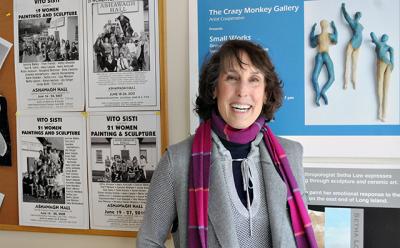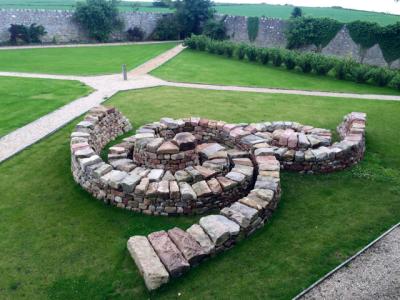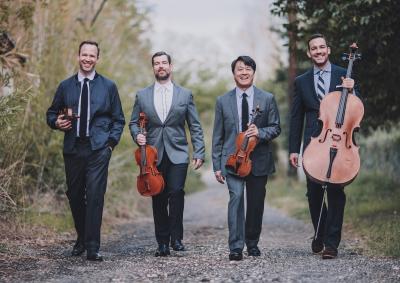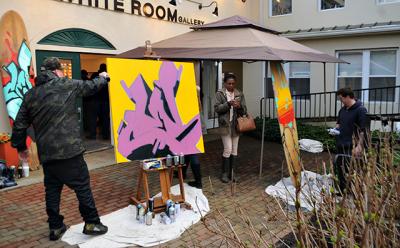Setha Low: Embracing the Other
Setha Low: Embracing the Other

Managing one career at a time is enough for most people, but not for Setha Low. After receiving her Ph.D. in anthropology from the University of California, Berkeley, in 1976, she established herself as a leading scholar and researcher in the field of cultural anthropology, focusing on the politics of public spaces, their increasing privatization, and the need to preserve diversity in their use.
By 2002, she had written or edited seven books, received dozens of fellowships, grants, and awards, and was a professor of environmental psychology and anthropology at the Graduate Center of the City University of New York. That same year she undertook a career as an artist, starting with a ceramics class in Bridgehampton.
Standing in the office of her house deep in Northwest Woods, she said, pointing to three ceramic sculptures on a high shelf, “Somewhere along the line I just decided I wanted something more in my life. I’m an academic who turned to art to get away from being an academic. When I’m making art I turn off my mind as much as possible, so whatever comes out is mediated by the unconscious or whatever is the other part of me.”
While her career as an anthropologist has continued apace since 2002 and shows no sign of slackening, she has produced since then a substantial body of ceramic sculpture that reflects a ceaselessly inquiring mind and a thirst for experimentation with different materials and techniques.
Speaking of the development of her art, Dr. Low said, “There’s this tacking back and forth between more and less classical or figurative work. I’m not concerned with being representational. I’ve always tried to work toward abstraction, but the figure keeps coming through.” That oscillation was exemplified by a comparison of “Unwrapped Copper,” a 12-inch-tall columnar ceramic piece in which the body is barely suggested, and a more classic bronze-glazed torso.
“I’ve been in a lot of places and seen art all over the world, in every culture,” she said. “My artwork is a lot about space and people. Some of it is intercultural, some of it arises from the fact that people have worked with clay forever, that it’s so human to express ourselves in clay.”
She brought out several black-and-white pieces. The black clay is the ground on which white liquid clay, or slip, is dripped. “These are very pure in that you’re using materials that are very organic, very early. The anthropologist in me would go to a site and see pots that are 10,000 years old, and I could see the thumb marks. I realized they pinched pots the way I pinch pots.”
Like much of her work, the black-and-white pieces, whose shapes resemble breastplates, refer to the human body as an object and as a surface. “These pieces especially are influenced by Australian Aboriginal work, the idea that they represent their landscape on the body. These are attempts to talk about different landscapes, to put my landscape on the body.”
She pointed out another piece consisting of shards of fired clay wrapped in mesh. “The idea here is that the clay pieces are always done intuitively, while the mesh means the city, urbanity, or civilization. I see clay as organic, original, earlier, and then when I start putting it with metal or leather I’m beginning to contrast that with the lives that we live.”
Dr. Low was born and raised in Los Angeles. Her stepfather was an actor, and her mother had a gift shop and always painted. She grew up with art, went to galleries, and spent a lot of time with artists. “I was just a little art groupie. Then I took an art class with my mother. She got an A and I got a C, so I gave that up and went the academic route.”
She started in biology and psychology at Pitzer College, one of the Claremont Colleges. “I was a very good biologist, and I went to graduate school as a physical or biological anthropologist. When I realized you couldn’t study people, just monkeys, as my best friend does — she studies baboons in Africa — I switched. It wasn’t that I didn’t love biology, but I thought the idea of living in the lab wasn’t for me.”
After graduate school she went to Latin America to do fieldwork, and since then has worked in Costa Rica, Guatemala, El Salvador, Mexico, the Dominican Republic, Cuba, Venezuela, the United States, Japan, Spain, France, and Italy, with site visits to Senegal, Kenya, Ghana, South Africa, Peru, Brazil, Ecuador, Chile, and Colombia.
Dr. Low was a professor of landscape architecture and regional planning, city planning, and anthropology at the University of Pennsylvania before moving, in 1989, to CUNY. “I’ve had an unusual career. There aren’t other anthropologists out there who do what I do. I wanted to replicate myself. In other words, I wanted to produce Ph.D. students who pulled from the various disciplines I was involved with.”
Her colleagues at CUNY have included David Harvey and the late Neil Smith, both of whom, like Dr. Low, have engaged the disciplines of psychology, earth and environmental science, anthropology, history, and geography. “David does it at a macro level. As an anthropologist, I do it on the ground, asking questions like, ‘Why are people living in gated communities? How do we maintain really diverse parks?’ ”
Another element affecting public space is surveillance, especially since 9/11. “I’m very interested in why Americans feel too afraid for the circumstances we’re living in. I just returned from Palestine, where there really is danger, and they are less afraid than we are. Here it has something to do with politics and the manipulation of fear. I want to look at it in everyday life and get people to stop for a moment and think about what would make them less fearful. And what would make them less fearful is to get to know ‘the other.’ ”
The concerns of her academic work are inseparable from those of her art. “There is something that artists speak about when they use the body as a landscape, and for me it’s sometimes about othering, and sometimes about violence, and sometimes about bringing us together. Sometimes it has to do with what I’m writing and sometimes with what I’m feeling or trying to work out. I’m trying to work against the conflict and bring us to a place where we would know the ‘other’ and be comfortable with it.”
Dr. Low, who first came to the East End in the summer of 1987, links her attachment to the area to growing up near the ocean in Los Angeles. She and her husband, Joel Lefkowitz, also a professor and the author of the book “Ethics and Values in Industrial-Organizational Psychology,” rented here for several summers before building their house in 1994.
“We thought it was a summer house, but we never left. I know the attachment has something to do with the light and the openness and the beauty and the ocean. I go to the beach, and I hike in the woods here. I believe the landscapes of our childhood get deeply within you, and the beach was important to me.” Because she teaches two days a week, they also have a house in Park Slope, but “every time I get here to where the sky opens up, I know I’m home.”




